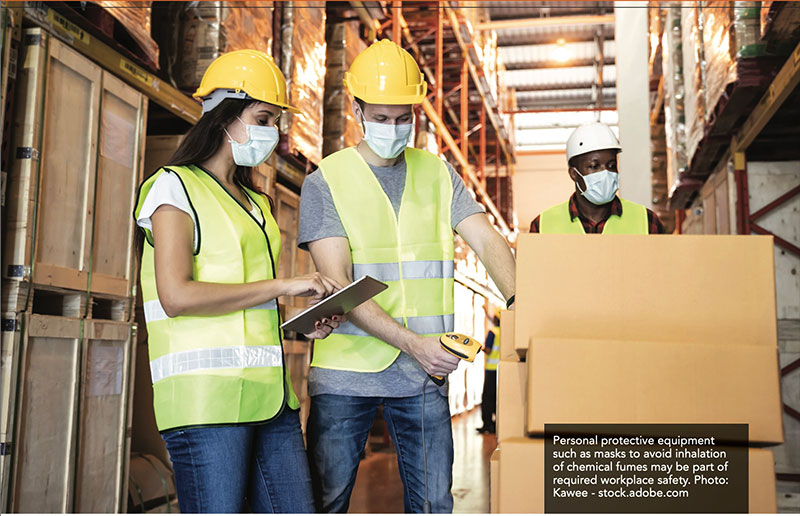Safety Compliance in the Printing and Packaging Industry
- Published: February 01, 2024

By Rick Farrell, President, PlantTours
By 2030, the packaging and printing market is expected to reach a valuation of $2.06 billion. Converters play a vital role in this market by transforming base materials like films and papers into customized, flexible packaging solutions. With so much growth happening in the industry, there’s also a growing demand for awareness of the best safety practices.
If you currently work as a leader in this sector, it’s critical that you understand the importance of safety compliance and key protocols that every printing and packaging facility should follow.
Understanding OSHA Regulations
The Occupational Safety and Health Administration (OSHA) has implemented several safety regulations for employees in the printing and packaging industry to abide by. The following are some of the most significant ones to be aware of:
Recordkeeping Guidelines
Employers covered by OSHA must maintain up-to-date records of job-related injuries and illnesses. This includes converters and other employers in the flexible packaging supply chain. Records should include the following forms:
- OSHA Form 300, an injury/illness log
- OSHA Form 301, an injury/illness incident report
- OSHA Form 300A, a summary of the incidents on Form 300
Reporting Guidelines
Employers must report to the nearest OSHA office within eight hours of an accident that results in a fatality or within 24 hours of an incident resulting in hospitalization, amputation or eye loss.
Lockout/Tag-Out Regulations
This regulation protects employees from unexpected machine startups and hazardous releases. Converters rely on a diversity of equipment — from printing presses and slitters to pouch fillers and sealers. It is critical converters implement a rigorous lockout/tagout program covering all production machines and lines.
That includes thorough procedures detailing isolation and lockout steps for energy sources on each piece of equipment. Converters must also train all employees on proper lockout techniques when performing maintenance or clearing jams. Regular audits should ensure converter lockout/tagout programs remain fully compliant and effective at protecting workers from hazardous energy.
Hazard Communication Guidelines
Some converters use a broad array of chemicals from printing inks to solvents and adhesives. These guidelines require information to be communicated to employees about the chemical hazards they are exposed to and protective measures that have been implemented to protect their health and safety. Examples of protective measures include a formal written program, safety data sheets for all relevant chemicals, employee training and precise container labels.
Machine Guarding Standards
Several standards are designed to protect employees from exposure to hazardous machine components. Converters must track possible injuries associated with all equipment, from printing presses to pouch fillers. Machinery like sheeters and flexographic printers also require fitting guards.
Machine guarding standards require physical guards to be provided to protect employees from exposure to and contact with moving parts.
Personal Protective Equipment Regulations
OSHA requires all employers to conduct a formal hazard assessment to determine whether and what personal protective equipment (PPE) is required, underlining the essential role of PPE in ensuring workplace safety. Employers must also provide personal protective equipment and train employees on proper use.
Examples of PPE that converter employees in the printing and packaging industry might use include protective gloves to avoid skin irritation from harsh chemicals, as well as masks to avoid the inhalation of fumes from these chemicals.
Key Safety Protocols for Printing and Packaging Operations
Detailed safety protocols are crucial for all employees in the printing and packaging industry. The following are some examples of protocols you can implement to safeguard employees and ensure OSHA compliance:
Regular First-Aid Training
Employers should provide first-aid training to all employees in the event of an accident, which will ensure that employees can take swift action — which could potentially be lifesaving.
Regular Schedule Reviews
Employers should review work schedules and shift patterns regularly to protect workers from fatigue. Being tired on the job increases the risk of mistakes or mishandling of equipment, both of which can cause accidents and injuries.

PPE Issuance
Employers must issue high-quality, relevant PPE to all team members and ensure every employee knows how and when to use it. For converter press operators, protective apparel needed for safe handling may include gloves, aprons and respiratory gear.
Regular Training Sessions
Training is an ongoing process, and all employees should be required to participate in regular training sessions. These sessions will provide refreshers to seasoned employees and will also familiarize new hires or temporary staff with the company’s safety policies.
Risk Assessment and Management in Print and Packaging Workplaces
An important part of developing and implementing a safety plan for your organization is conducting a thorough risk assessment. An assessment enables you to identify specific hazards and create a protocol for shielding employees from them.
An effective risk assessment should include the following steps:
- Risk Identification: The first step is figuring out what the specific risks and hazards in the facility are.
- Risk Analysis: The second step involves a detailed consideration of hazards, potential accidents, the consequences of those accidents, the likelihood that they will occur, etc.
- Risk Evaluation: The third step involves careful examination of the risk analysis to determine where additional controls might be needed, as well as what those controls might be.
For instance, when examining risks, converters need to study factors like the likelihood of slitter jams and possible operator finger amputations.
The Importance of Hazard Communication in Print Production and Warehouses
Effective warehouse communication also plays a vital part in keeping printing and packaging facilities — as well as the employees who work in them — safe. Proper communication, especially regarding workplace hazards, ensures that everyone is on the same page regarding risks and how to avoid them.
Here are some examples of how employers can improve hazard communication protocols:
Identify and Appoint Responsible Staff — Effective communication starts with knowing who is responsible for developing safety protocols and communicating them with the rest of the team. Employers should appoint specific staff members to spearhead safety programs and ensure everyone knows who has been selected.
Prepare and Implement a Written Program — The staff member or members in charge of the safety program should carefully document all company protocols and share those protocols with all team members. The safety rules and guidelines should be available in multiple languages to ensure everyone understands.
Ensure Containers Are Labeled Properly — Careful labeling is critical, especially when it comes to chemicals used in printing and packaging facilities. All containers should have clear labels indicating what they contain and whether or not the substance is hazardous.
Create and Maintain Safety Data Sheets — Safety data sheets provide detailed information on particular hazardous chemicals. Employers should ensure they create and maintain these data sheets and ensure that workers have access to them.
Regularly Evaluate and Reassess the Program — A safety program requires continuous evaluation and assessment. Employers should review the program regularly to ensure it is up to date and is effectively protecting employees from accidents, injuries, illnesses, etc.
In Conclusion
Safety compliance plays an essential role in helping printing and packaging facilities run as smoothly as possible. By following the guidelines above with a converter-specific risk analysis lens, employers can help safeguard the health and safety of flexible packaging line staff.
Keeping converter personnel safe through training, procedures, and equipment investments fosters a culture dedicated to operational excellence.
About the Author
Rick Farrell is an expert in improving manufacturing group communication, education, training and group hospitality processes. He has over 40 years of group hospitality experience, serving as President of PlantTours for the last 18 years. He has provided consulting services with the majority of For- tune 500 industrial corporations improving group communication dynamics of all types in manufacturing environments.



